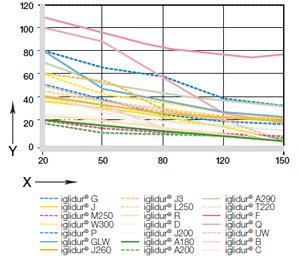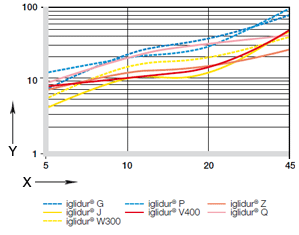iglidur® - Load
The load on a plain bearing is expressed by the surface pressure (p) on MPa (corresponds to N/mm2 With it the radial load is distributed over the projected surface of the bearing.
Radial bearing: p = F/d1 * b1
For axial bearings the load arises accordingly.
Axial bearing: p = F/(d22 - d12) * π/4
Present is
| F | Load in N |
| d1 | Inner diameter of the bearing in mm |
| b1 | Bearing length in mm |
| d2 | Outer diameter of the bearing in mm |
A characteristic value of the iglidur® materials is the maximum recommended surface pressure [p], static at +20℃. The individual iglidur® bearings differ from each other very clearly on this point. The characteristic value [p] gives the load capacity of a plain bearing. The bearing can continuously tolerate this load without any damage. The stated value applies to the static operation; only very slow speeds up to 0.01 m/s are permitted with this load. Higher loads are possible if the duration of the stress is short. Please call us if you have any questions.
Figures 02 and 03 show the maximum recommended surface pressure of the iglidur® bearings through the temperature.
With increasing temperature, this value decreases continuously. You may utilize the possibilities to calculate the iglidur® bearings to detect such effects beforehand, or determine the effective temperatures in the test.
With decreasing radial load, the bearing increases the permitted surface speed. The product can be understood as a measurement for the heating of the bearing from the load [p] and the speed [v], the so-called pv-value. This connection is clarified by the pv diagram, which can be found for each iglidur® material at the beginning of each section.
The bearing load influences the bearing wear. The following diagram shows for instance the wear behavior of the iglidur® bearing materials. It is good to keep in mind that for every load there is an ideal bearing. Wear is expressed as wear rate [μm/km].
With increasing load, the bearing's coefficient of friction typically reduces. In this connection, shaft material and surfaces are likewise of importance.
More than 100,000 products available! Delivery and consultation Mon-Fri from 7am-8pm and Sat from 8am-12pm!



